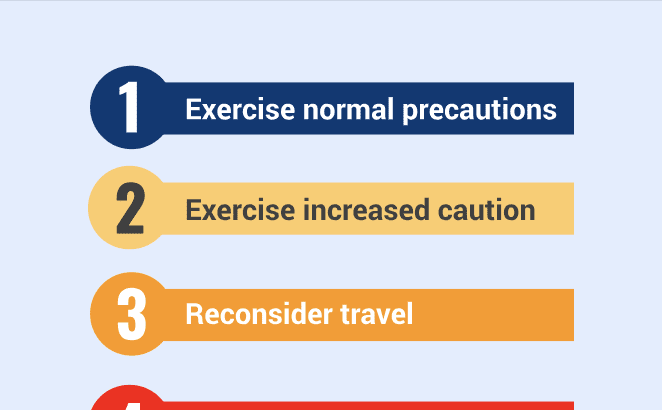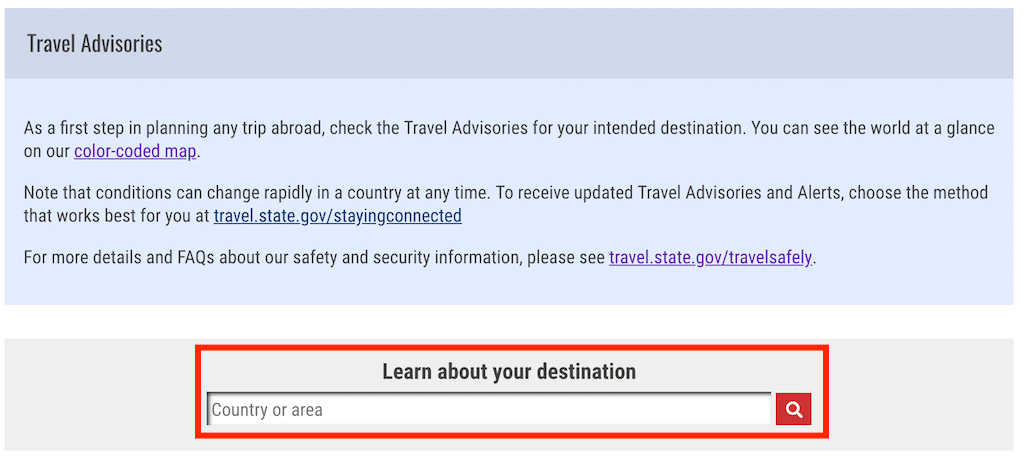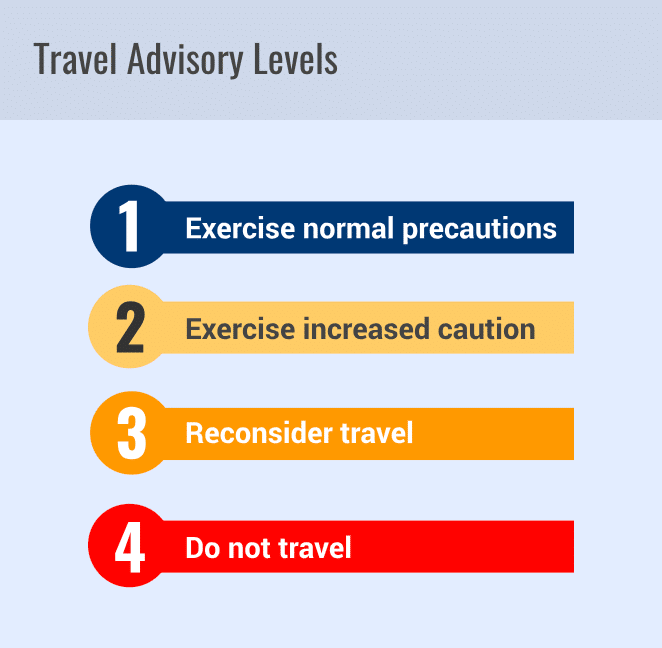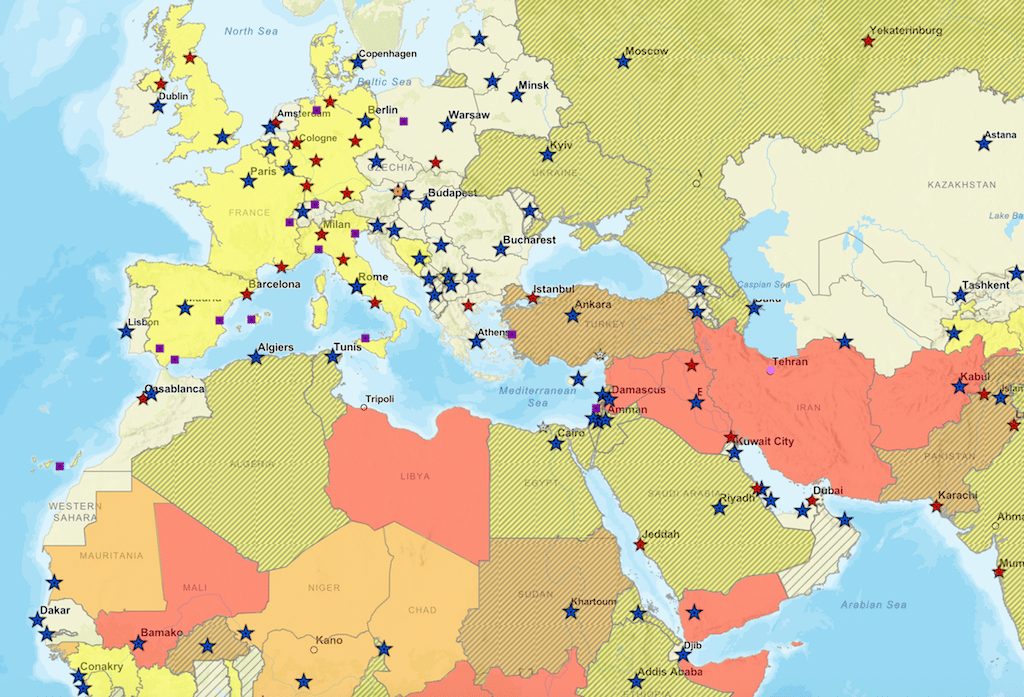Have you ever seen a news article or read something about the government issuing a travel advisory for a specific country? Do you know what those travel advisories mean and what you should do about them?
In this article, I will talk about the new system that the US Department of State uses to issue travel advisories. I’ll go through the different advisory levels and types of threats, and I also will talk about how you can register for alerts and make it easier for the government and your family to contact you in the event of an emergency.
Table of Contents
What are US travel advisories?
Travel advisories are advisories issued by the US Department of State that are meant to inform you about the current risk levels for traveling to specific destinations. There are currently four different levels of advisories that are issued and these advisories are based on specific potential risks, such as crime or terrorism.
Tip: Use the free app WalletFlo to help you travel the world for free by finding the best travel credit cards and promotions!
How to check for travel advisories
You can find the current travel advisories issued by the US Department of State here.
The easiest way to search for travel advisories is to simply enter the name of the country into the search bar. You can also sort the chart found on that page by name, advisory level, or by the last update.
I recommend utilizing the search bar because if you click on a country directly from the chart, you will only be able to view the travel advisory. However if you pull up the country via the search bar you can see a lot of additional information about that country, such as alerts, country facts, US government building contact details, and other important information.
Below, I will go into detail about these different levels of advisories and talk about the different types of risks that you might want to investigate.
Travel advisory warning system
In January 2018, the US Department of State issued a new type of warning system including four different levels to travel advisories.
- Level one: Exercise normal precautions
- Level two: Exercise increased caution
- Level three: Reconsider travel
- Level four: Do not travel
These warning levels will be based on the following potential threats:
C – Crime:
Widespread violent or organized crime is present in areas of the country. Local law enforcement may have limited ability to respond to serious crimes.
T – Terrorism:
Terrorist attacks have occurred and/or specific threats against civilians, groups, or other targets may exist.
U – Civil Unrest:
Political, economic, religious, and/or ethnic instability exists and may cause violence, major disruptions, and/or safety risks.
H – Health:
Health risks, including current disease outbreaks or a crisis that disrupts a country’s medical infrastructure, are present. The issuance of a Centers for Disease Control Travel Notice may be a factor.
N – Natural Disaster:
A natural disaster, or its aftermath, poses danger.
E – Time-limited Event:
A short-term event, such as an election, sporting event, or other incident that may pose a safety risk.
O – Other:
There are potential risks not covered by previous risk indicators. Read the country’s Travel Advisory for details.
Below, I will discuss each of the advisory tiers and give you some examples of what kind of risks you can expect.
Travel advisory levels
Level one: Exercise normal precautions
This is the lowest security level and it includes many countries that you would probably feel very safe traveling in such as: Canada, Japan, Singapore, South Korea, Taiwan, Costa Rica and many others. There are also some countries you may not expect to see on the list like: Barbados, Liberia, Botswana, Granada, Morocco and others.
Being on the level one list obviously doesn’t mean that bad things or unexpected attacks won’t happen in those countries but it just means that you do not need to be on a heightened level of alert.
Level two: Exercise increased caution
For level two, you need to be aware of heightened risks to safety and security. Countries that fall into this list include: the Maldives, Egypt, India, France, Belgium, United Kingdom, Spain, Italy, Jamaica, Belize, China, and others.
Another country is Mexico. They are on the list due to crime and the department states that, “Violent crime, such as homicide, kidnapping, carjacking, and robbery, is widespread.”
The advisory mentions specific areas within Mexico to avoid In these include:
- Colima state due to crime.
- Guerrero state due to crime.
- Michoacán state due to crime.
- Sinaloa state due to crime.
- Tamaulipas state due to crime.
Not every region is on the same warning level. For example, here are some of the different warning levels for different regions.
- Aguascalientes state – Level 2: Exercise Increased Caution
- Baja California state – Level 2: Exercise Increased Caution
- Chihuahua state – Level 3: Reconsider Travel
- Colima state – Level 4: Do Not Travel
So Mexico actually has three different levels of warnings. This is why it is very important to check on the specific warning levels for where you are going to be within a country. Even in smaller countries, the level of danger can vary dramatically in different parts of the region.
Level three: Reconsider travel
The US Department of State states to avoid travel due to serious risks to safety and security for level three countries. An example of a level three country is Turkey. They made the level three list due to terrorism and arbitrary detentions.
There is also a level four warning warning for certain parts of the country including the provinces of Hatay, Kilis, Gaziantep, Sanliurfa, Sirnak, Diyarbakir, Van, Siirt, Mus, Mardin, Batman, Bingol, Tunceli, Hakkari, and Bitlis.
Level four: Do not travel
This is the highest advisory level due to greater likelihood of life-threatening risks. During an emergency, the U.S. government may have very limited ability to provide assistance. The Department of State advises that U.S. citizens not travel to the country or leave as soon as it is safe to do so.
These are very dangerous places like South Sudan, where even journalists are targets and civil unrest is widespread.
Here’s what the Department of State has to say about South Sudan:
Violent crime, such as carjackings, shootings, ambushes, assaults, robberies, and kidnappings is common throughout South Sudan, including Juba. Foreign nationals have been the victims of rape, sexual assault, armed robberies, and other violent crimes.
Armed conflict is ongoing throughout the country and includes fighting between various political and ethnic groups, and weapons are readily available to the population. In addition, cattle raids occur throughout the country and often lead to violence. Reporting in South Sudan without the proper documentation from the South Sudanese Media Authority is considered illegal, and any journalistic work there is very dangerous. Journalists regularly report being harassed in South Sudan, and many have been killed while covering the conflict in South Sudan.
My personal take
Personally, I would try to avoid any destinations with a warning level above two. I would consider visiting places with warning levels at three if the specific city or region I was going to was well removed from the danger zone and research suggested that there would not be any issues with passports, visas, etc. However, I would not want to venture to a level four destination because even if you can avoid danger it can get tricky getting out of those countries.
I once worked in immigration law and I remember seeing cases where people were simply at the wrong place at the wrong time during civil demonstrations and riots. As a result, they were detained and then a long and tiring process began to clear their name and get them out the country. So my advice would be to steer clear of those areas that would have potential uprisings.
Department of State’s Worldwide Caution
The Department of State also issues a worldwide warning. They encourage US citizens to “maintain a high level of vigilance and practice good situational awareness when traveling abroad.”
They specifically warned about threats at the following places:
- high-profile public events (sporting contests, political rallies, demonstrations, holiday events, celebratory gatherings, etc.)
- hotels, clubs, and restaurants
- places of worship
- schools
- parks
- shopping malls and markets
- tourism infrastructure
- public transportation systems
- airports
Unfortunately, those are pretty much the same types of places where incidents happen on our own turf in the US, so in reality it is just a good idea to be vigilant wherever you go in today’s world.
Tip: Use WalletFlo for all your credit card needs. It’s free and will help you optimize your rewards and savings!
Travel advisory map
There is a very helpful travel advisory map that you can use. You can easily see the advisory level for each country based on the color it is filled in with.
Another very helpful tool is that you can see the location for government facilities located within that country.
These include the following:
- Embassy
- Consulate General
- Consulate
- Consular Agent
- Consular Section
- U.S. Protecting Power
Typically, as a tourist the Embassy can help you but you are most likely going to visit the Consulate, Consulate General, or a Consular Agent/Section to resolve your issues. These Consulate offices typically have normal business hours such as being open from 8am to 5pm. If something ever happened outside of those hours, you will need to call a duty officer.
The after-hours duty officer will be able to help you with anything that is considered an emergency. For example, if you need to leave the country ASAP or are in danger then they can help you out. However, if you simply just misplaced a passport or something like that you will likely have to wait until the Consulate offices open up.
Research the local consulate office for the phone number to the duty officer number close to you.
STEP registration
The Smart Traveler Enrollment Program (STEP) is a free service to allow U.S. citizens and nationals traveling and living abroad to register/enroll their trip with the nearest U.S. Embassy or Consulate.
With this you can receive important information from the Embassy about safety conditions in your destination country. So if you are planning on visiting a destination, you can sign up for notifications and always be updated when things are changing country.
You can also make it easier for the U.S. Embassy contact you in an emergency, whether natural disaster, civil unrest, or family emergency.
So even if you are not visiting a dangerous country, it could still be worth it to sign-up for this program because there could be some sort of a natural disaster or something happening with a family emergency.
If you have family members who constantly worry about you when you go traveling internationally, this is a great way to make them feel better.
Find out more about this program here.
Final word
It is always a good idea to check on the latest advisories for any countries that you are thinking about visiting or moving to. But make sure that you do more than just check the warning levels in that you look into the specific details on why there are advisories and What regions are most affected by them.
It’s also a good idea to check the map to see where local government buildings will be and to sign up for the STEP program to make it easier for people to contact you and for you to stay up-to-date.
Daniel Gillaspia is the Founder of UponArriving.com and the credit card app, WalletFlo. He is a former attorney turned travel expert covering destinations along with TSA, airline, and hotel policies. Since 2014, his content has been featured in publications such as National Geographic, Smithsonian Magazine, and CNBC. Read my bio.





